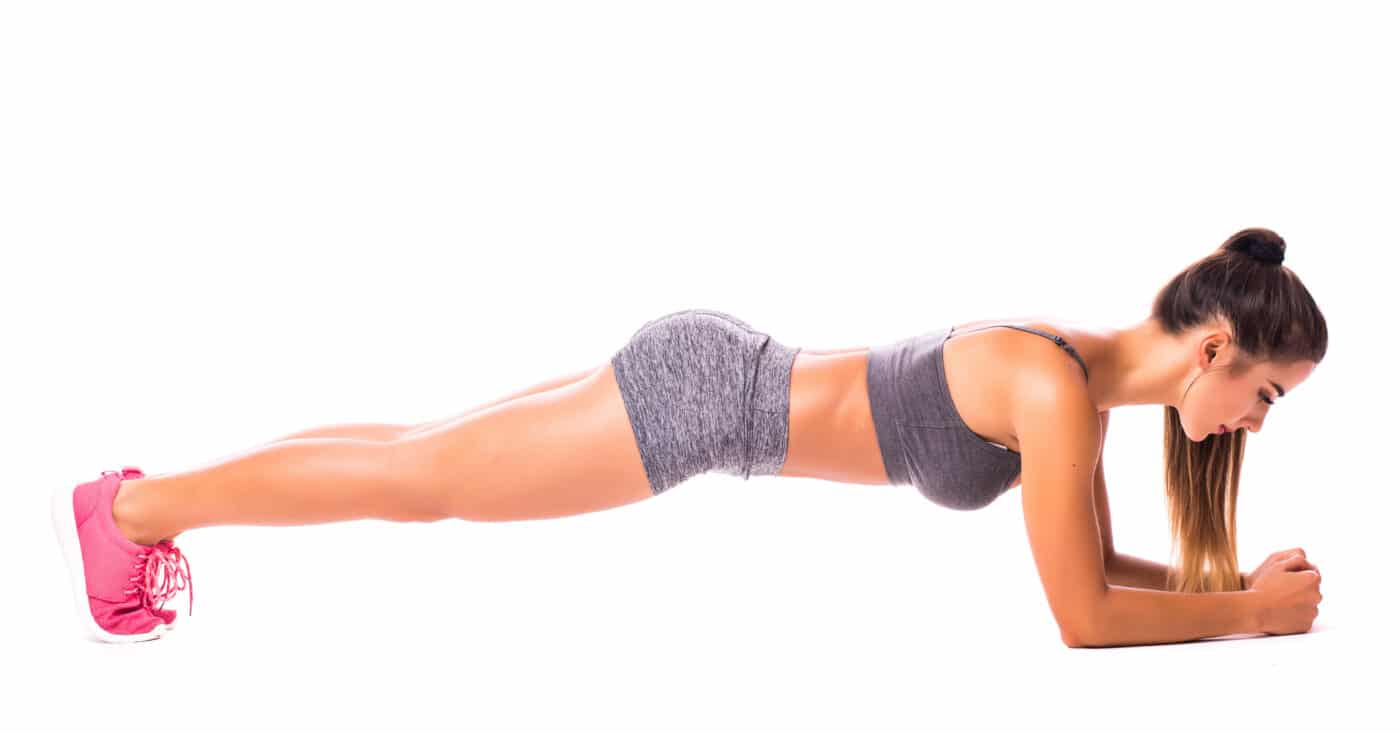Many a complex workout has been cobbled together in search of the Holy Grail of abdominal exercises. After all, a well-toned six-pack is the symbol of an attractive body and therefore the fitness goal par excellence for both women and men. But a strong core doesn't even require a highly complex workout. The good old Planks and a little time are already enough. Wondering how to do it? We'll show you what's important and which plank variations are the best.
What are Planks?
Strictly speaking, the Plank is nothing more than a simple forearm support. It is therefore a static holding exercise that trains a large part of the skeletal muscles. The longer you hold the plank position exactly, the greater the muscle tension and thus also the training stimulus for the muscles.
And this is how the classic Planks work:
Kneel on the floor, bend your upper body forward and place your forearms side by side on the floor.
Position your elbows below your shoulders and make sure your forearms are parallel to each other.
3. direct your gaze forward, now stretch your legs backwards and place your feet on the balls of your feet.
Tighten your abdomen and make sure that your body forms a straight line from your verses to your buttocks, back and neck.
5. hold the tension as long as you can, pull in the belly button and breathe in and out slowly during the exercise.
Once you can no longer hold the position, lower your body for 60 seconds before starting the second pass.
Which muscles are trained by planks?
The Plank is much more than just an exercise for the middle of the body. In addition to the straight abdominal muscles (m. rectus abdominis, m. pyramidalis) and the lateral abdominal muscles (m. obliquus externus abdominis, m. obliquus internus abdominis, m. traversus abdominis), the exercise also trains the shoulder muscles, the butt muscles, the chest, the thighs and even parts of the back muscles. In doing so, the tension not only affects the muscles close to the surface, but also the deeper muscles and muscle strands that can hardly be addressed with many other exercises.
Why should I perform Planks?
Well, planks are an extremely effective exercise that you don't even need equipment for. All you need to perform it is a little space and a good 5 minutes of your time. The Plank is an excellent exercise for strengthening the abdominal muscles, easy to learn and has very little risk of injury due to its low complexity. However, the Plank is not only ideal for building muscle, but especially for building core stability. After all, it involves static holding work, the type of muscle work for which the abdominal muscles are primarily designed by nature.
The Planks are therefore the standard exercise for every athlete, because a strong body core is the basis for the development of maximum performance in almost every sport. So if you want to increase your performance and reduce your susceptibility to injury in soccer, American soccer, track and field, swimming or cycling, the Plank is the exercise of choice.
What is the best way to integrate planks into your workout?
The beauty of planking is that you can easily integrate the exercise into your training. Accordingly, you have many options in practice. A very simple, flexible and time-saving method is planking in the morning. Choose three to four days per week on which you perform a short plank workout directly after getting up. This takes no longer than 5 minutes and is an excellent energizer for the day.
Because of the small amount of space and time required, the lunch break is also ideal. Alternatively, incorporate the planks into your regular workout. Either use them as a regular exercise or use the set breaks between other abdominal exercises or other exercises in general for a plank run. This makes the workout especially intense and also saves a lot of time.
What do I have to consider with Planks?
The most important factor, as with all other exercises, is the absolutely clean execution of the exercise, because only then can you train the target muscles as effectively as possible. Therefore, make sure that your upper body always forms an absolutely straight line. Only in this way is the focus of the muscle tension really in the area of the abdominal muscles.
Otherwise, the buttocks, back and hips will take on too much work. And that's not the point, after all. Optimal muscle tension is at least as important as the right form. This means that immediately after assuming the basic position, you must make sure to tense your abdominal muscles hard. This in turn increases the effectiveness of planking enormously.
How to avoid the biggest mistakes with Planks
Even though the exercise looks relatively simple, and in principle it is, there are enough things you can do wrong with the Plank.
Avoid the following mistakes to perform the exercise as effectively as possible:
- Shift the angle of the upper body: Especially when you perform a Plank version that is performed on the hands rather than the forearms, mistakes often occur that reduce the effectiveness of the exercise. Many exercisers tend to reduce the tension by placing the arms in front of the shoulders, thus increasing the angle between the upper body and the arms. In both the hands-on and forearms-on versions, the elbows and shoulders must be exactly on top of each other.
- Lifting the buttocks too high: If you lift your butt too high, you are performing a typical compensatory movement that takes tension out of your abdominal muscles. This happens especially when your abdominal muscles are still a little too weak. There's only one thing that helps here: slowly work your way up with short but clean planks until you can hold the exact position for longer.
- Allow the body to sag: This is also a compensatory movement that indicates that the abdominal muscles are too weak. The solution to the problem is also the same as the previously mentioned point.
- Compensate for strength deficits with the upper body: The abdominal muscles are often much weaker than, for example, the chest, shoulder muscles or latissimus. As a result, many exercisers use their upper body to compensate for strength deficits during planking. You can recognize this mistake by the fact that your upper back is rounded and you feel the pull mainly in your chest and back.
- Letting the neck sag: While this mistake hardly affects the training effect, it can lead to uncomfortable neck tension or even neck injuries. So always make sure that your neck is in line with the rest of your body. This works ideally if you fix a point in front of you on the floor and fix it with your gaze during the entire exercise.
The 3 best plank variations for your six pack
The classic planks are already excellent for strengthening the abdominal muscles. If you want to make your workout a little more intense, you can resort to other variations. Here are the three best options for your six pack.
Planks for the lateral abdominal muscles
1. get into the plank position as we described at the beginning and tighten your buttocks, abdomen and back strongly.
Slowly push your hips to the right and rotate them in until you feel a pull in the lateral abdominal muscles. Hold the position for 30 to 60 seconds.
Now slowly rotate your hips to the left and hold the position for 30 to 60 seconds.
Planks with arm rotation
1. assume the standard position, but lean on your hands instead of your forearms.
Lift one arm off the floor and turn your torso to the side so that your arm is pointing toward the ceiling. Hold the position.
Return slowly to the starting position and repeat the exercise with your other arm.
4. to achieve a clean shape, you should always follow your arm with your gaze.
Lateral planks with arm and leg lift off
1. assume the lateral forearm support and make sure that your elbow is below your shoulder. Place your right leg on top of your left leg.
Now lift your right leg and spread it upwards.
At the same time, lift your right arm and extend it forward. Hold the tension in the muscles for 30 to 60 seconds.
Return slowly to the starting position and take a short break. Once you have completed 8 to 12 repetitions, switch sides and perform 8 to 12 repetitions as well.




